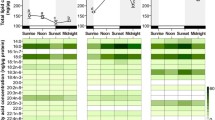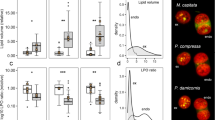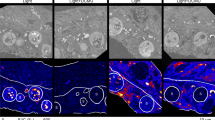Abstract
Cnidaria–dinoflagellate endosymbiosis is the phenomenon of autotrophic symbionts living inside the gastrodermal cells of their animal hosts. The molecular mechanism that regulates this association remains unclear. Using quantitative microscopy, we now provide evidence that the dynamic lipid changes in gastrodermal “lipid bodies” (LBs) reflect the symbiotic status of the host cell and its symbiont in the hermatypic coral Euphyllia glabrescens. By dual-emission ratiometric imaging with a solvatochromic fluorescent probe, Nile red (9-diethylamino-5H-benzo[α]phenoxazine-5-one), we showed that the in situ distribution of polar versus neutral lipids in LBs in living gastrodermal cells and symbionts can be analyzed. The ratio of Nile red fluorescence at red (R) versus green (G) wavelength region (i.e., R/G ratio) correlated with the relative molar ratio of polar (P) versus neutral (NP) lipids (i.e., P/NP ratio). The R/G ratio in host LBs increased after bleaching, indicating a decrease in neutral lipid accumulation in gastrodermal cells. On the other hand, neutral lipid accumulation inside the symbiont LBs resulted in gradual decreases of the R/G ratio as a result of bleaching. In comparison with the bleaching event, there was no relative lipid concentration change in host LBs under continual light or dark treatments as shown by insignificant R/G ratio shift. Patterns of R/G ratio shift in symbiont LBs were also different between corals undergoing bleaching and continual light/dark treatment. In the latter, there was little lipid accumulation in symbionts, with no resulting R/G ratio decrease. These results, demonstrating that the symbiotic status positively correlated with morphological and compositional changes of lipid bodies, not only highlight the pivotal role of LBs, but also implicate an involvement of lipid trafficking in regulating the endosymbiosis.







Similar content being viewed by others
References
Alonzo F, Mayzand P (1999) Spectrofluorometric quantification of neutral and polar lipids in zooplankton using Nile red. Mar Chem 67:289–301
Arndt-Jovin DJ, Robert-Nicoud M, Kaufman SJ, Jovin TM (1985) Fluorescence digital imaging microscopy in cell biology. Science 230:247–256
Battey JF, Patton JS (1984) A reevaluation of the role of glycerol in carbon translocation in zooxanthellae-coelenterate symbiosis. Mar Biol 79:27–38
Biel KY, Gates RD, Muscatine L (2007) Effects of free amino acids on the photosynthetic carbon metabolism of symbiotic dinoflagellates. Russ J Plant Physiol 54:365–371
Bligh EG, Dyer WJ (1959) A rapid method for total lipid extraction and purification. Can J Biochem Physiol 37:911–917
Bright GR, Fisher GW, Rogowska J, Taylor DL (1987) Fluorescence ratio imaging microscopy: temporal and spatial measurements of cytoplasmic pH. J Cell Biol 104:1019–1033
Chen CS (2002) Phorbol ester induces elevated oxidative activity and alkalization in a subset of lysosomes. BMC Cell Biol 3:21–31
Chen CS, Martin OC, Pagano RE (1997) Changes in the spectral properties of a plasma membrane lipid analog during the first seconds of endocytosis in living cells. Biophy J 72:37–50
Chen CS, Yeh CC, Lin HP, Fang LS (2005) The use of a fluorescent membrane probe to identify zooxanthellae in hospite among dissociated endoderm cell culture from coral. Protoplasma 226:175–179
Coleman RA, Lee DP (2004) Enzymes of triacylglycerol synthesis and their regulation. Prog Lipid Res 43:134–176
Day RW, Quinn GP (1989) Comparisons of treatments after an analysis of variance in ecology. Ecol Monogr 59:433–463
D’Elia CF (1977) The uptake and release of dissolved phosphorus by reef corals. Limnol Oceanogr 22:301–315
D’Elia CF, Domotor SL, Webb KL (1983) Nutrient uptake kinetics of freshly isolated zooxanthellae. Mar Biol 75:157–167
Diaz G, Melis M, Batetta B, Angius F, Falchi AM (2008) Hydrophobic characterization of intracellular lipids in situ by Nile red red/yellow emission ratio. Micron 39:819–824
Douglas AE (2003) Coral bleaching-how and why. Mar Poll Bull 46:385–392
Dubinsky Z, Aaronson S (1978) Increase of lipid yields from some algae by acid extraction. Phytochemistry 18:51–52
Duncan RE, Ahmadian M, Jaworski K, Sarkadi-Nagy E, Sul HS (2007) Regulation of lipolysis in adipocytes. Annu Rev Nutr 27:79–101
Elsey D, Jameson D, Raleigh B, Cooney MJ (2007) Fluorescent measurement of microalgal neutral lipids. J Microbiol Methods 68:639–642
Fowler SD, Greenspan P (1985) Application of Nile red, a fluorescent hydrophobic probe, for the detection of neutral lipid deposits in tissue section: comparison with Oil red O. J Histochem Cytochem 33:833–836
Franklin DJ, Hoegh-Guldberg O, Jones RJ, Berges JA (2004) Cell death and degeneration in the symbiotic dinoflagellates of the coral Stylophora pistillata during bleaching. Mar Ecol Prog Ser 272:117–130
Gates RD, Muscatine L (1992) Three methods for isolating viable anthozoan endoderm cells with their intracellular symbiotic dinoflagellates. Coral Reefs 11:143–145
Greenspan P, Fowler SD (1985) Spectrofluorometric studies of the lipid probe, nile red. J Lipid Res 26:781–789
Greenspan P, Mayer EP, Fowler SD (1985) Nile red: a selective fluorescent stain for intracellular lipid droplets. J Cell Biol 100:965–973
Hohman TC, McNeil PL, Muscatine L (1982) Phagosome-lysosome fusion inhibited by algal symbionts of Hydra viridis. J Cell Biol 94:56–63
Igal RA, Coleman RA (1996) Acylglycerol recycling from triacylglycerol to phospholipid, not lipase activity, is defective in neutral lipid storage disease fibroblasts. J Biol Cell 271:16644–16651
Imanishi Y, Gerke V, Palcewski (2004) Retinosomes: new insights into intracellular managing of hydrophobic substances in lipid bodies. J Cell Biol 166:447–453
Jeffrey SW, Humphrey GF (1975) New spectrophotometric equations for determining chlorophylls a, b, c1 and c2 in higher plants, algae, and natural phytoplankton. Biochem Physiol Pflanz 167:191–194
Kellogg RB, Patton JS (1983) Lipid droplets, medium of energy exchange in the symbiotic anemone Condylactis gigantean: a model coral polyp. Mar Biol 75:137–149
Klinkner AM, Bugelski PJ, Waites CR, Louden C, Hart TK, Kerns WD (1997) A novel technique for mapping the lipid composition of atherosclerotic fatty streaks by en face fluorescence microscopy. J Histochem Cytochem 45:743–753
Knot HJ, Laher I, Sobie EA, Guatimosim S, Gomez-Viquez L, Hartmann H, Song LS, Lederer WJ, Graier WF, Malli R, Frieden M, Petersen OH (2005) Twenty years of calcium imaging: cell physiology to dye for. Mol Interventions 5:112–127
Kremer JMH, Esker MWJ, Pathmamanoharan C, Wiersema PH (1977) Vesicles of variable diameter prepared by a modified injection method. Biochemistry 16:3932–3935
Kwok ACM, Wong JTY (2005) Lipid biosynthesis and its coordination with cell cycle progression. Plant Cell Physiol 46:1973–1986
Liu P, Ying Y, Zhao Y, Mundy DI, Zhu M, Anderson RGW (2004) Chinese hamster ovary K2 cell lipid droplets appear to be metabolic organelles involved in membrane traffic. J Biol Chem 279:3787–3792
Martin S, Parton RG (2005) Caveolin, cholesterol, and lipid bodies. Semin Cell Dev Biol 16:163–174
Martin S, Parton RG (2006) Lipid droplets: a unified view of a dynamic organelle. Nat Rev Mol Cell Biol 7:373–378
Maxfield FR, Tabas I (2005) Role of cholesterol and lipid organization in diseases. Nature 438:612–621
Muscatine L (1967) Glycerol excretion by symbiotic algae from corals and Tridacna and its control by the host. Science 156:516–519
Muscatine L, Goiran C, Land L, Jaubert J, Cuif J-P, Allemand D (2005) Stable isotopes (δ13 C and δ15N) of organic matrix from coral skeleton. Proc Natl Acad Sci USA 102:1525–1530
Nakamura K, Handa S (1984) Coomassie brilliant blue staining of lipids on thin-layer plates. Anal Biochem 142:406–410
Patton JS, Burris JE (1983) Lipid synthesis and extrusion by freshly isolated zooxanthellae (symbiotic algae). Mar Biol 75:131–136
Peng SE, Luo YJ, Huang HJ, Lee IT, Hou LS, Chen WNU, Fang LS, Chen CS (2008) Isolation of tissue layers in hermatypic corals by N-acetylcysteine: morphological and proteomic examinations. Coral Reefs 27:133–142
Priscu JC, Priscu LR, Palmisano AC, Sullican CW (1990) Estimation of neutral lipid levels in Antarctic sea ice microalgae by nile red fluorescence. Antarctic Sci 2:149–155
Trench RK (1971) The physiology and biochemistry of zooxanthellae symbiotic with marine coelenterates. III. The effect of homogenates of host tissues on the excretion of photosynthetic products in vitro by zooxanthellae from two marine coelenterates. Proc R Soc Lond B 177:251–264
Turró S, Ingelmo-Torres M, Estanyol JM, Tebar F, Fernández MA, Albor CV, Gaus K, Grewal T, Enrich C, Pol A (2006) Identification and characterization of associated with lipid droplet protein 1: a novel membrane-associated protein that resides on hepatic lipid droplets. Traffic 7:1254–1269
Umlauf E, Csaszar E, Moertelmaier M, Schuetz GJ, Parton RG, Prohaska R (2004) Association of stomatin with lipid bodies. J Biol Chem 279:23699–23709
Veldhuis MJW, Kraay GW, Timmermans KR (2001) Cell death in phytoplankton: correlation between changes in membrane permeability, photosynthetic activity, pigmentation and growth. Eur J Phycol 36:167–177
Venn AA, Loram JE, Douglas AE (2008) Photosynthetic symbioses in animals. J Exp Bot 59:1069–1080
Wang JT, Douglas AE (1997) Nutrients, signals, and photosynthate release by symbiotic algae: the impact of taurine on the dinoflagellate alga Symbiodinium from the sea anemone Aiptasia pulchella. Plant Physiol 114:631–636
Acknowledgments
This work was supported by grants from the National Science Council NSC 95-2311-B-291-003-MY2, and by intramural funding from the National Museum of Marine Biology and Aquarium. We thank members of the endosymbiosis group, two anonymous reviewers, and the editor for comments on the manuscript.
Author information
Authors and Affiliations
Corresponding author
Additional information
Communicated by Biology Editor Dr. Ruth Gates
Rights and permissions
About this article
Cite this article
Luo, YJ., Wang, LH., Chen, WN.U. et al. Ratiometric imaging of gastrodermal lipid bodies in coral–dinoflagellate endosymbiosis. Coral Reefs 28, 289–301 (2009). https://doi.org/10.1007/s00338-008-0462-8
Received:
Revised:
Accepted:
Published:
Issue Date:
DOI: https://doi.org/10.1007/s00338-008-0462-8




